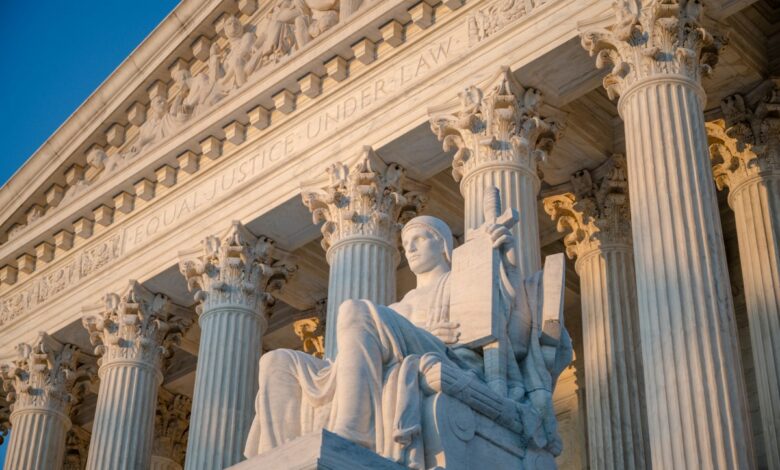The Supreme Court could decide the future of content moderation — or it could punt

The Supreme Court is considering the fate of two state laws that limit how social media companies can moderate the content on their platforms.
In oral arguments on Monday, the justices grappled with a thorny set of questions that could reshape the internet, from social networks like Facebook and TikTok to apps like Yelp and Etsy.
In October, the Supreme Court decided to hear the two parallel cases, one in Florida (Moody v. NetChoice, LLC) and one in Texas (NetChoice, LLC v. Paxton). In both instances, signed into law by Republican governors, a new state law instructed social media companies to stop removing certain kinds of content.
Florida’s Senate Bill 7072 prevents social media companies from banning political candidates or putting restrictions on their content. In Texas, House Bill 20 told social media companies that they could no longer remove or demonetize content based on the “viewpoint represented in the user’s expression.” In Florida, a federal appeals court mostly ruled in favor of the tech companies, but in Texas the appeals court sided with the state.
The two laws were both crafted by Republican lawmakers to punish social media companies for their perceived anti-conservative bias. Those accusations have not been borne out by research, but conservative social media users are disproportionately exposed to political misinformation, which could explain perceptions of an ideological discrepancy in tech’s content moderation decisions.
The Florida and Texas laws are now tangled up in a complex web of dusty legal precedents, largely drawing on rulings created long before words like “tweet” and “livestream” were part of everyday speech. Because most laws governing the modern internet are so outdated, tech companies and their critics alike are eager for clarity — though as the Supreme Court demonstrated last year with a different pair of social media cases, they may not get it.
On Monday, justices on both sides of the political spectrum sounded skeptical about the pair of state laws. In oral arguments, Justice Sonia Sotomayor called the cases “odd,” warning that their broad nature could have unforeseen impacts.
“It seems like your law is covering just about every social media platform on the Internet, and we have amici who are not traditional social media platforms, like smartphones and others who have submitted amici briefs, telling them that readings of this law could cover them,” Sotomayor said, referencing the Florida law.
“This is so, so broad, it’s covering almost everything. But the one thing I know about the Internet is that its variety is infinite.” Sotomayor pointed to the online marketplace Etsy as a less obvious example of a website that could be negatively impacted by state laws designed to dictate what social media companies can do.
Addressing Florida Solicitor General Henry Whitaker, Justice Brett Kavanaugh brought up the First Amendment — but not in a way sympathetic to the state’s argument.
“You said the design of the First Amendment is to prevent ‘suppression of speech,’ Kavanaugh said. “And you left out what I understand to be three key words in the First Amendment or to describe the First Amendment, “by the government.”
Even Justice Neil Gorsuch, who seemed more sympathetic to critical arguments against the social networks, pointed to Section 230, a longstanding law that protects internet companies’ content moderation decisions, noting that it likely “preempts” the state limits on social media moderation.
Not all of the justices seemed to side with the tech industry. Justices Clarence Thomas and Samuel Alito appeared to find the states’ arguments more compelling than their peers, with Alito at one point asking if the idea of content moderation was “anything more than a euphemism for censorship.”
Monday’s hearing provided some clarity on where the majority of justices seem to stand now, but anything can happen — including nothing. A handful of justices, including Justices Sotomayor, Gorsuch, Barrett and Thomas expressed uncertainty about the way the cases were brought to begin with.
“It’s called a facial challenge, because on the face of the law a challenger alleges what the legislature has done is unconstitutional,” Paul Barrett, NYU adjunct law professor and Deputy Director of NYU Stern’s Center for Business and Human Rights, told TechCrunch. “It’s a case where a party, in this case industry trade groups, go to court, even before the law goes into operation. And they say to the trial judge, ‘this law is unconstitutional, no matter how it gets applied.’
“They asked the judge at that point for an injunction that says the law is not to go into effect. By doing that, there isn’t the usual supply of facts and figures and experience and so forth, there isn’t testimony that allows an appellate court to see how the law works in practice.”
The Supreme Court could issue a decisive ruling any time between now and when the court’s term ends in June. Or it could decline to rule on the issues at hand and opt to kick the cases back down to lower courts for a full trial, a process that could take years. “Supreme Court cases can fizzle in this way, much to the frustration in most cases to other parties,” Barrett said.
Either way, the highest court in the land will have to face the internet age head-on eventually. Many of the relevant legal precedents deal with cable TV, newspapers or utility companies — not internet businesses with many millions or even billions of users.
“It’s clear that the Supreme Court needs to update its First Amendment jurisprudence to take into account this vast technological change,” Barrett said. “… The Supreme Court often lags behind society in dealing with these kinds of things, and now it’s time to deal with it.”
Source link




